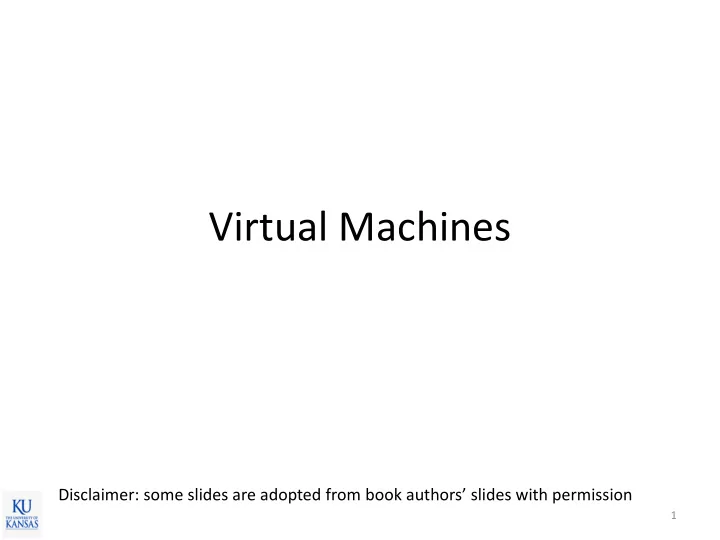

Virtual Machines Disclaimer: some slides are adopted from book authors’ slides with permission 1
Recap: Virtual Machines • Enabling technology of cloud computing • Basic idea: Provide machine abstractions 2
Recap: Virtual Machines • Benefits – Can run multiple OSes , each in its own virtual machine – Can copy a VM image and run it on a different machine – Can create a snapshot of the state and restore it later – Can create a customized VM with specific OS version and libraries to avoid version dependency problems – More efficient resource utilization is possible • Downsides ? – Overhead – Interference 3
Today • How to implement VMMs? • How to reduce overhead? 4
How to Implement a VMM? • Emulators – Many game consoles are emulated – In theory, any h/w can be emulated (virtualized) via s/w • Language based virtual machines – Instead of virtualizing real hardware, provide a specially designed virtual hardware for specific languages – JVM for Java, CLR for MS .Net • Common issues: performance 5
Java Virtual Machine Performance killer Java byte code 6
How to Implement a VMM? • Modern VMMs – Normal instructions are executed on the real CPU • In case of emulator, each instruction is executed in s/w • No performance loss for user-mode instructions – Any “unusual” instrs cause traps to the VMM • Privileged instructions (e.g., addr. space change) • Kernel calls in the guest OS 7
Instructions Types • Normal instructions – add, sub, load/store, branch, … – Execute natively • Privileged instructions – Setup page tables, load/flush TLB and caches • LGDT, LLDT, LTR, MOV <Control Reg>, LMSW, … – Mode change, system state monitor • HLT, RDMSR, WRMSR, RDPMC 8
Trap and Emulation in VMM • Virtualize privileged instructions – Guests run in user-mode, generating exceptions 9
Binary Translation • Some instructions are not virtualizable – Execute in both user and kernel modes, but behave differently (e.g., popf) 10
Types of VMM OS OS • Native (or Type 1) VMM VMM – VMM runs directly on top of bare hardware – Vmware ESX, Microsoft Hyper-V Hardware – VMM is a kind of a OS on its own right OS OS • Hosted (or Type 2) VMM – VMM runs within an OS App VMM – VirtualBox, VMWare Workstation OS – VMM relies on functionalities of the host OS Hardware 11
VMware WorkStation (Player) 12
How to Virtualize Hardware? • CPU • Memory • Events – Exceptions, interrupts • I/O devices – Disk, network 13
Virtualizing the CPU • Virtual CPU (vCPU) – One or more vCPUs for every VM – Seen as physical CPU for the guest OS on the VM • How? – Timeslice the CPU – Just like CPU scheduling in OS – VMM uses CFS like scheduler(s) 14
VMM Timesharing 15
Virtualizing Memory • OS view – Virtual address physical address • VMM view – Guest virtual guest physical VMM physical – Does MMU know about VMM physical??? – Originally no, but now yes • Intel/AMD support nest page tables Intel EPT (extended page table) 16
Virtualizing Interrupts & I/O • VMM receives h/w interrupts – Determines which VM to receive – Emulate interrupt controller for the VM • VMM emulate a specific h/w devices – Guest OS VMM devices • E.g., AMD Lance PCNet ethernet device • Lots of I/O performance killers 17
Para-virtualization • Idea: provides simple/fast APIs to guests – Instead of emulating actual hardware (e.g., PCNet32 ethernet card) – Pros • can be a lot faster (more efficient I/O) – Cons • need to modify the guest OS 18
I/O in Xen via Shared Buffer 19
IOMMU • Problem: How to do DMA in a VM? – DMA controller needs host physical address, not guest physical address • IOMMU – MMU for IO devices – maps guest physical host physical for the I/O devices https://en.wikipedia.org/wiki/Input%E2%80%93out put_memory_management_unit#/media/File:MM 20 U_and_IOMMU.svg
LXC: OS (Linux) Container Ubuntu Ubuntu CentOS 14.04 12.04 Php, mysql, Php, mysql, Php, mysql, Nginx Nginx Nginx Container Container Container Linux kernel Hardware • Same kernel, separate user-space • Virtualize OS, not machine • Low overhead, flexible 21
Docker: Application Container Ubu Cent Ubu Php App2 App2 ntu OS ntu Ngin mysq App1 App2 App1 App2 Contai x l ner Linux kernel Hardware • A container contain one application (process) • Built on top of OS containers • Even more flexible 22
Summary • Virtual Machine (hardware virtualization) – Trap & emulate – Binary translation – Para-virtualization – Hardware support for virtualization • Containers – OS container: same kernel, different user-space – App container: same kernel, per-process space 23
Recommend
More recommend